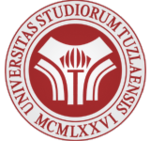
The University of Ljubljana, abbreviated UL, is the oldest and largest university in Slovenia. It has approximately 38,000 enrolled students. The university has 23 faculties and three art academies with approximately 4,000 teaching and research staff, assisted by approximately 2,000 technical and administrative staff. The University of Ljubljana offers programs in the humanities, sciences, and technology, as well as in medicine, dentistry, and veterinary science.

The University of Zagreb is a public research university in Zagreb, Croatia. It is the largest Croatian university and one of the oldest continuously operating universities in Europe. The University of Zagreb and the University North are the only public universities operating in Northern and Central Croatia.

The University of Belgrade is a public research university in Belgrade, Serbia. It is the oldest and largest modern university in Serbia.
A faculty is a division within a university or college comprising one subject area or a group of related subject areas, possibly also delimited by level. In North America, academic divisions are sometimes titled colleges, schools, or departments, with universities occasionally using a mixture of terminology, e.g., Harvard University has a Faculty of Arts and Sciences and a Law School.
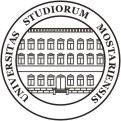
The University of Mostar is the largest public university located in Mostar, Bosnia and Herzegovina.

Education in Bosnia and Herzegovina has a long history, the first classifiable higher-education institution having been established a school of Sufi philosophy by Gazi Husrev-beg in 1531, with numerous other religious schools following suit over time. In 1887, under de facto Austro-Hungarian Empire control, a Sharia Law School began a five-year program. In the 1940s the University of Sarajevo became the city's first secular higher education institute. In the 1950s post-bachelaurate graduate degrees became available. Severely damaged during the war, it was recently rebuilt in partnership with more than 40 other universities. There are various other institutions of higher education, including: University of Banja Luka, University of Mostar, University of Tuzla, University of Zenica, University of East Sarajevo, University Džemal Bijedić of Mostar, University of Bihać, American University in Bosnia and Herzegovina, etc.

The University of Sarajevo is a public university located in Sarajevo, Bosnia and Herzegovina. It is the largest and oldest university in the country, tracing its initial origins to 1537 as an Islamic madrasa.

Ivo Pilar was a Croatian historian, politician, publicist and lawyer, considered the father of Croatian geopolitics. His book The South Slav Question is a seminal work on the South Slav geopolitical issues.

The University of Split is a university located in Split, Croatia. It was founded in 1974. and is organized in 13 faculties and 124 faculty programmes. As of 2009, a total of approximately 40,000 students have graduated, and a total of 337 doctoral degrees have been awarded.
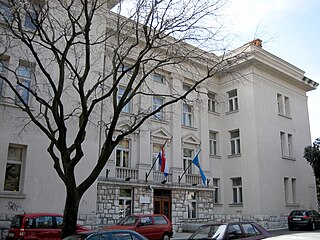
The University of Rijeka is in the city of Rijeka, Croatia, with faculties in cities throughout the regions of Primorje, Istria and Lika.

The University of Banja Luka is the second-oldest university in Bosnia and Herzegovina. A public university, it is the flagship institution of higher education in Republika Srpska, one of two entities of Bosnia and Herzegovina. As of 2018–19 school year, there are 11,186 enrolled students.

The University of Zanjan (ZNU) is located in Zanjan, Iran. It was founded in 1975 and organized into four faculties. Nowadays it is one of the largest universities in the country, with a community of over 10,000 students.
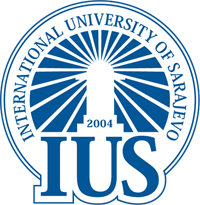
The International University of Sarajevo (IUS) is a private university located in the capital city Sarajevo, Bosnia and Herzegovina. The university was established by the Foundation for the Development of Education in 2004–2005. IUS is open to students from all over the world, and the language of instruction and communication is English. It offers four year education according to Bologna system. IUS has 1650 students from 55 countries and faculty members from 20 countries performing academic and research activities in various disciplines of Science, Engineering, Arts and Social Sciences. The first generation of 32 IUS graduates received their diplomas on June 26, 2009. IUS offers many types of scholarships, especially for students from Bosnia and Herzegovina. IUS has both modern and large campus for the region.
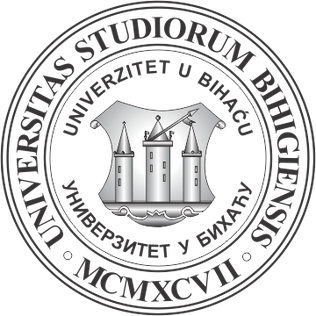
The University of Bihać is a public university located in Bihać, Bosnia and Herzegovina. It was established on 28 July 1997.

The University of East Sarajevo is a public university located in Lukavica, East Sarajevo, Republika Srpska, Bosnia and Herzegovina.

The School of Economics and Business (SEBS) is a business school affiliated with the University of Sarajevo. It is often known by its former name, the Faculty of Economics

Denis Bećirović is a Bosnian politician, professor and historian serving as the 8th and current Bosniak member of the Presidency of Bosnia and Herzegovina since 2022. He has also been serving as its chairman since March 2024. Previously, Bećirović was a member of the national House of Peoples from 2019 to 2022. He is also the current vice-president of the Social Democratic Party.

The Faculty of Humanities is the oldest and one of the most prominent faculties of the University of Sarajevo in Bosnia and Herzegovina. The institution was established on 14 February 1950 by the decision of the People's Republic of Bosnia and Herzegovina.

The Faculty of Philosophy of the University of East Sarajevo abbreviated as FFUIS is a constituent faculty of the University of East Sarajevo located in Pale, a university town twenty kilometers away from Sarajevo in Republika Srpska, Bosnia and Herzegovina. The Faculty is the largest organizational unit of the University of East Sarajevo. It is one of only five faculties of philosophy in the country.
